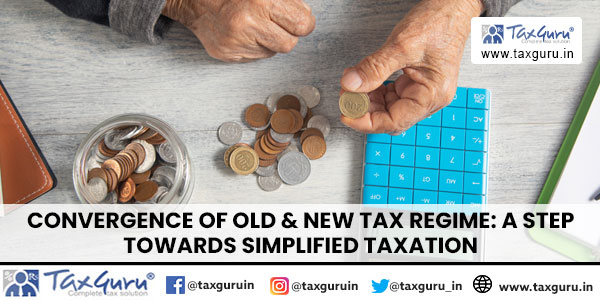1.0 Background
India’s existing taxation system for individual taxpayers presents a dichotomy with two distinct personal tax regimes i.e. the old tax regime and the new default (concessional) tax regime. While the old regime provides the taxpayers with an option for claiming various exemptions and deductions, the new regime provides for concessional tax rates while imposing restrictions on claiming most of the exemptions or deductions. Such alternative system of taxation, though designed to offer flexibility, has resulted in complexity for taxpayers requiring them to do detailed comparisons to determine the most beneficial option.
In this article, we explore the challenges faced by the taxpayers in such dual system of tax regime and the possibility of a unified tax regime that simplifies as well as rationalizes individual taxation.

2.0 Existing Alternative Regimes – Challenges faced by the Taxpayers
2.1 Complexity in Tax Computation: Most of the individual taxpayers, especially salaried taxpayers, (other than HNI’s and individuals deriving income from Profit/Gains from Business/Profession) compute their tax liability and file ITR on their own without any professional assistance. Thus, at times, it becomes quite difficult for them to assess and choose the most favorable tax regime which optimises their tax liability and suits their financial needs.
2.2 Rigidity in Switching between the Tax Regimes: The taxpayers would have an option of choosing between the old and the new tax regime on a year-on-year basis. However, it is pertinent to note that a person deriving income from business or profession who has exercised the option of opting out of the prevalent new tax regime u/s 115BAC could exercise the option of opting back to the said new tax regime only once.
2.3 Limited Adoption of the New Regime: Despite its goal of simplifying taxation and being made the default tax regime vide Finance Act 2023 (as applicable for FY 2023-24 onwards), the New Tax Regime has still not gained widespread acceptance amongst taxpayers due to the restrictions imposed on the claiming the deductions as well as exemptions. Particularly, the exclusion of certain deductions, such as standard deductions for salaried individuals and health insurance premiums, has led many taxpayers to favour the Old Tax Regime.
3.0 Proposed Unified Tax Regime System
3.1 Rationalisation of Tax Slabs under the New Tax Regime:
A unified tax structure that converges elements of the Old and New Tax Regimes can simplify compliance while retaining taxpayer benefits. The following rationalized tax slab structure combines the flexibility of the Old Regime’s deductions with the concessional rates of the New Regime:
| Tax Slabs | Tax Rates |
| Upto Rs. 5,00,000 | Nil |
| Rs. 5,00,001 to Rs. 10,00,000 | 5% |
| Rs. 10,00,001 to Rs. 15,00,000 | 10% |
| Rs. 15,00,001 to Rs. 20,00,000 | 15% |
| Rs. 20,00,001 to Rs. 25,00,000 | 20% |
| Rs. 25,00,001 to Rs. 30,00,000 | 25% |
| Above Rs. 30,00,000 | 30% |
Introducing additional tax slabs or adjusting existing slabs to reduce the steepness of the tax rate increase can provide relief. For example, a possible adjustment could be introducing a 25% tax rate for income between 25 lakhs and 30 lakhs, and retaining 30% for income above 30 lakhs. This would create a more gradual progression in tax rates for higher incomes, thereby reducing the overall tax burden. A more progressive tax structure would not only ease the financial burden on higher-income individuals but also incentivize greater compliance and economic participation
3.2 Availability of Certain Deductions:
The New Tax Regime restricts taxpayers from claiming most deductions, except for the following key deductions:
- Standard Deduction u/s 16(ia): Enhanced Salary Deduction of Rs. 75,000 (Rs. 50,000 available in the old tax regime)
- Family Pension u/s 57(iia): the limit has also been increased to Rs. 25,000 (Rs. 15,000 available in the old tax regime)
- Deduction in respect of the amount paid or deposited in the Agniveer Corpus Fund u/s 80CCH(2) of the IT Act
- Section 80CCD(2): Employer’s Contribution to NPS for the benefit of Employees
To enhance its appeal, the following additional deductions should be permitted, addressing contemporary needs:
Section 80C (Life Insurance Premium and Other Investments): Allowing deductions for social security payments, such as Life Insurance Premiums (LIC), investments in National Savings Certificates, and Public Provident Funds, would provide taxpayers with security benefits while promoting investment in sovereign-backed instruments.
Section 80D (Medical Insurance Premiums): The pandemic has underscored the importance of medical well-being, with most individuals incurring health-related expenses. Allowing this deduction in the New Tax Regime would alleviate concerns and make the regime more attractive.
Section 80EEB (Electric Vehicle Loan Interest): With the shift towards electric vehicles, taxpayers benefit from a deduction of up to ₹1,50,000 on loan interest under this section. Including this deduction in the New Tax Regime would encourage eco-friendly investments and attract more taxpayers.
Allowing Interest on housing loan deduction and Setoff of House Property Loss: Currently, individuals under the New Tax Regime cannot claim any interest paid on housing loan and also cannot set off house property losses against income from other heads. Many taxpayers incur losses from newly acquired self-occupied properties due to market dynamics and liberalization. Allowing such deduction of interest and also setoff of losses under the New Tax Regime would provide relief and encourage a broader adoption of the regime.






one important suggestion is omitted. The income tax rates should be linked with Inflation index like US for real income tax calculation. Now dearness allowance which is granted for compensation for erosion of salary/wages is again included in tax though there is no real income. Now because of ever increase of inflation real income decreases but income tax is increased thereby people are suffering from want of basic living conditions. Really why this suggestion is not given by all economic experts. In US the exemption and rates are linked with Inflation index every year. This should be done in India immediately permanently without the Government approval each year.